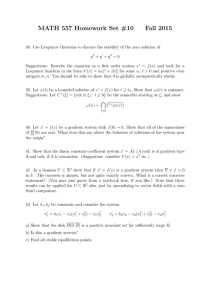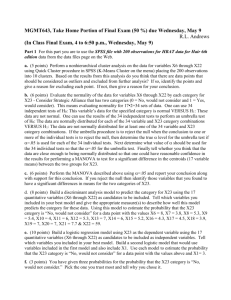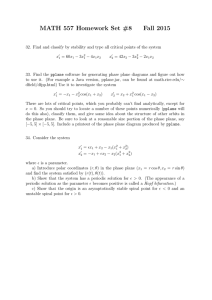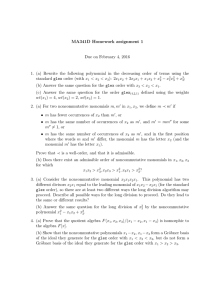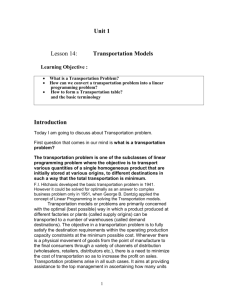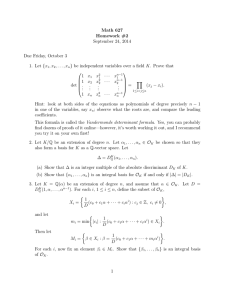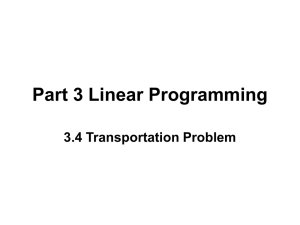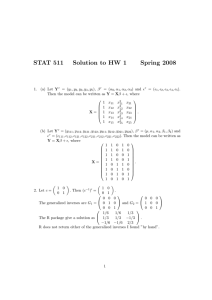A Lie Group
advertisement
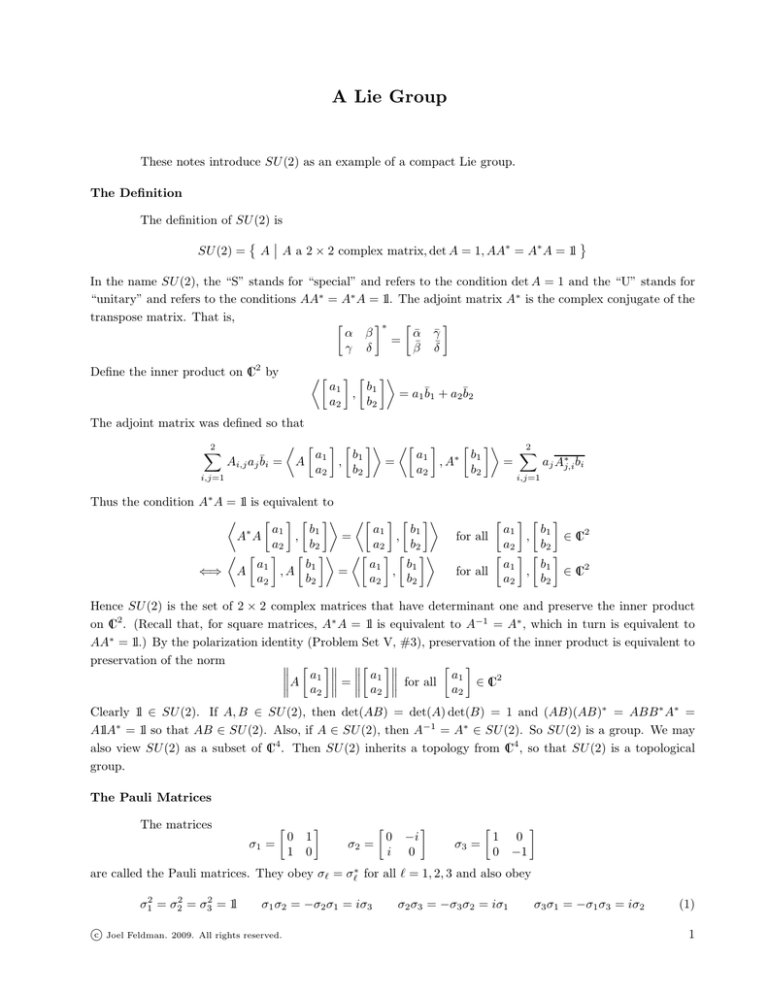
A Lie Group
These notes introduce SU (2) as an example of a compact Lie group.
The Definition
The definition of SU (2) is
SU (2) =
A A a 2 × 2 complex matrix, det A = 1, AA∗ = A∗ A = 1l
In the name SU (2), the “S” stands for “special” and refers to the condition det A = 1 and the “U” stands for
“unitary” and refers to the conditions AA∗ = A∗ A = 1l. The adjoint matrix A∗ is the complex conjugate of the
transpose matrix. That is,
∗ α β
ᾱ γ̄
=
γ δ
β̄ δ̄
Define the inner product on C2 by
b
a1
= a1 b̄1 + a2 b̄2
, 1
b2
a2
The adjoint matrix was defined so that
2
X
Ai,j aj b̄i =
2
X
a
b
b
a1
aj A∗j,i bi
A 1 , 1
=
=
, A∗ 1
a2
b2
b2
a2
i,j=1
i,j=1
Thus the condition A∗ A = 1l is equivalent to
a
b
a1
b
A∗ A 1 , 1
=
, 1
a2
b2
a2
b2
b
a1
b
a
, 1
=
⇐⇒ A 1 , A 1
b2
a2
b2
a2
a1
b
, 1 ∈ C2
a2
b2
b
a1
, 1 ∈ C2
for all
b2
a2
for all
Hence SU (2) is the set of 2 × 2 complex matrices that have determinant one and preserve the inner product
on C2 . (Recall that, for square matrices, A∗ A = 1l is equivalent to A−1 = A∗ , which in turn is equivalent to
AA∗ = 1l.) By the polarization identity (Problem Set V, #3), preservation of the inner product is equivalent to
preservation of the norm
A a1 = a1 for all a1 ∈ C2
a2
a2 a2 Clearly 1l ∈ SU (2). If A, B ∈ SU (2), then det(AB) = det(A) det(B) = 1 and (AB)(AB)∗ = ABB ∗ A∗ =
A1lA∗ = 1l so that AB ∈ SU (2). Also, if A ∈ SU (2), then A−1 = A∗ ∈ SU (2). So SU (2) is a group. We may
also view SU (2) as a subset of C4 . Then SU (2) inherits a topology from C4 , so that SU (2) is a topological
group.
The Pauli Matrices
The matrices
0 1
σ1 =
1 0
0
σ2 =
i
−i
0
1 0
σ3 =
0 −1
are called the Pauli matrices. They obey σℓ = σℓ∗ for all ℓ = 1, 2, 3 and also obey
σ12 = σ22 = σ32 = 1l
c Joel Feldman.
σ1 σ2 = −σ2 σ1 = iσ3
2009. All rights reserved.
σ2 σ3 = −σ3 σ2 = iσ1
σ3 σ1 = −σ1 σ3 = iσ2
(1)
1
Set, for each ~a = (a1 , a2 , a3 ) ∈ IR3 , the matrix
~a · ~σ = a1 σ1 + a2 σ2 + a3 σ3
Then the product rules (1) can be written
~a · ~σ ~b · ~σ = ~a · ~b 1l + i~a × ~b · ~σ
(2)
I claim that any 2×2 complex matrix has a unique representation of the form a0 1l+ia1 σ1 +ia2 σ2 +ia3 σ3
for some a0 , a1 , a2 , a3 ∈ C. This is easy to see. Since
a0 + ia3 ia1 + a2
a0 1l + ia1 σ1 + ia2 σ2 + ia3 σ3 =
ia1 − a2 a0 − ia3
we have that
α β
a0 1l + ia1 σ1 + ia2 σ2 + ia3 σ3 =
γ δ
⇐⇒ a0 =
α+δ
2 ,
a1 =
β+γ
2i ,
a2 =
β−γ
2 ,
a3 =
α−δ
2i
Lemma.
SU (2) =
Proof:
x0 1l + i~x · ~σ (x0 , ~x) ∈ IR4 , x20 + k~xk2 = 1
Let A be any 2 × 2 complex matrix and write A = a0 1l + i~a · ~σ with ~a = (a1 , a2 , a3 ). Then by (2)
AA∗ = a0 1l + i~a · ~σ a0 1l − i~a · ~σ
= |a0 |2 1l + ia0~a · ~σ − ia0~a · ~σ + ~a · ~a1l + i~a × ~a · ~σ
= |a0 |2 + k~ak2 1l + i a0~a − a0~a + ~a × ~a · ~σ
Hence
AA∗ = 1l ⇐⇒ |a0 |2 + k~ak2 = 1, a0~a − a0~a + ~a × ~a = 0
First, suppose that ~a 6= ~0. Since ~a × ~a is orthogonal to both ~a and ~a, the equation a0~a − a0~a + ~a × ~a = 0 can be
satisfied only if ~a × ~a = 0. That is, only if ~a and ~a are parallel. Since ~a and ~a have the same length, this is the
case only if ~a = e−2iθ~a for some real number θ. This is equivalent to e−iθ~a = e−iθ~a which says that ~x = e−iθ~a
is real. Subbing ~a = eiθ ~x back into a0~a − a0~a + ~a × ~a = 0 gives
eiθ a0 ~x − e−iθ a0 ~x = 0
This forces a0 = eiθ x0 for some real x0 . If ~a = ~0, we may still choose θ so that a0 = eiθ x0 . We have now shown
that
AA∗ = 1l ⇐⇒ A = eiθ x0 1l + i~x · ~σ for some (x0 , ~x) ∈ IR4 with |x0 |2 + k~xk2 = 1 and some θ ∈ IR
Since
det A = det e
iθ
x0 1l + i~x · ~σ = det e
iθ
x0 + ix3
ix1 − x2
ix1 + x2
x0 − ix3
= e2iθ (x20 + x21 + x22 + x23 ) = e2iθ
we have that det A = 1 if and only if eiθ = ±1. If eiθ = −1, we can absorb the −1 into (x0 , ~x).
c Joel Feldman.
2009. All rights reserved.
2
As consequences of this Lemma we have that SU (2) is
◦ homeomorphic to S 3 , the unit sphere in IR4
◦ connected
◦ simply connected (meaning that every continuous closed curve in SU (2) can be continuously deformed
to a point)
◦ is a C ∞ manifold (meaning, roughly speaking, that in a neighbourhood of each point, we may choose
three of x0 , x1 , x2 , x3 as coordinates, with the fourth then determined as a C ∞ function of the chosen
three)
A topological group that is also a C ∞ manifold (with the maps (a, b) 7→ ab and a 7→ a−1 C ∞ when expressed
in local coordinates) is called a Lie Group.
The Connection between SU (2) and SO(3)
Define
M : IR3 → V =
~a · ~σ ~a ∈ IR3 ⊂ {2 × 2 complex matrices}
~a 7→ M (~a) = ~a · ~σ
This is a linear bijection between IR3 and V . (In fact V is the space of all 2 × 2 traceless, self–adjoint matrices.)
Each U ∈ SU (2) determines a linear map S(U ) on IR3 by
M S(U )~a = U M (~a)U −1
(3)
The right hand side is clearly linear in ~a. But it is not so clear that U M (~a)U −1 is in V , that is, of the form
M (~b). To check this, we let U = x0 1l + i~x · ~σ with (x0 , ~x) ∈ IR4 obeying kx0 k2 + k~xk2 = 1 and compute
U M (~a)U −1 = U M (~a)U ∗ explicitly. Applying (2) twice
U M (~a)U −1 = x0 1l + i~x · ~σ ~a · ~σ x0 1l − i~x · ~σ
= x0 1l + i~x · ~σ x0~a · ~σ − i~a · ~x1l + ~a × ~x · ~σ
= x20~a · ~σ − ix0~a · ~x1l + x0~a × ~x · ~σ
+ ix0 ~x · ~a1l − x0 ~x × ~a · ~σ + ~a · ~x ~x · ~σ + i~x · (~a × ~x)1l − ~x × (~a × ~x) · ~σ
=
x20~a
· ~σ + 2x0~a × ~x · ~σ + ~a · ~x ~x · ~σ − ~x × (~a × ~x) · ~σ
since ~x is perpendicular to (~a × ~x). Using ~c × (~a × ~b) = (~b · ~c)~a − (~a · ~c)~b,
U M (~a)U −1 = x20~a · ~σ + 2x0~a × ~x · ~σ + ~a · ~x ~x · ~σ − k~xk2~a · ~σ + ~a · ~x ~x · ~σ
= x20 − k~xk2 ~a · ~σ + 2x0~a × ~x · ~σ + 2~a · ~x ~x · ~σ
This shows, not only that U M (~a)U −1 ∈ V , but also that, for U = x0 1l + i~x · ~σ ,
S(U )~a = x20 − k~xk2 ~a − 2x0 ~x × ~a + 2~a · ~x ~x
In fact, we can exactly identify the geometric operation that S(U ) implements. If U = ±1l, that is ~x = ~0, then
it is obvious from (3) that S(U )~a = ~a for all ~a ∈ IR3 . That is, both S(1l) and S(−1l) are the identity map
on IR3 . If ~x 6= ~0, there is a unique angle 0 < θ < 2π and a unique unit vector ê such that x0 = cos( θ2 ) and
~x = − sin( θ2 ) ê. If ~a happens to be parallel to ~x, that is, ~a = c ~x,
S(U )~a = x20 − k~xk2 ~a + 2~a · ~x ~x = x20 + k~xk2 ~a = ~a
So S(U ) leaves the axis ~x invariant. If ~a is not parallel to ~x, set
k̂ = ê
c Joel Feldman.
2009. All rights reserved.
ı̂ =
~
a−~
a·k̂ k̂
k~
a−~
a·k̂ k̂k
̂ = k̂ × ı̂
3
This is an orthonormal basis for IR3 . Since ~a is a linear combination of ı̂ and k̂,
~a = ~a · k̂ k̂ + ~a · ı̂ ı̂
In terms of this notation
S(U )~a = cos(θ) ~a + sin(θ) ê × ~a + 2 sin2 ( θ2 ) ~a · ê ê
= ~a · ê ê + cos(θ) (~a − ~a · ê ê) + sin(θ) ê × ~a
Since
~a − ~a · ê ê = ~a − ~a · k̂ k̂ = ~a · ı̂ ı̂
ê × ~a = k̂ × ~a = k̂ × ~a · k̂ k̂ + ~a · ı̂ ı̂ = ~a · ı̂ ̂
we have
S(U )~a = ~a · k̂ k̂ + cos(θ) ~a · ı̂ ı̂ + sin(θ) ~a · ı̂ ̂
In particular
S(U )k̂ = k̂
S(U )ı̂ = cos(θ) ı̂ + sin(θ) ̂
This is exactly the rotation of ~a about the axis k̂ = ê (the k̂ component of ~a is unchanged) by an angle θ (the
part of ~a perpendicular to k̂ has changed by a rotation by θ as in IR2 ). This shows that
S : SU (2) → SO(3)
that S is surjective and that S(U ) = 1l3 , the identity map on IR3 , if and only if U = ±1l. Also, by (3),
−1
M S(U U ′ )~a = U U ′ M (a)U ′ U −1 = U M S(U ′ )~a U −1 = M S(U )S(U ′ )~a
so that S(U U ′ ) = S(U )S(U ′ ) and S is a homomorphism. It is not injective, since S(−1l) = S(1l). Indeed S is a
two to one map since
S(U ) = S(Ũ ) ⇐⇒ S(U )S(Ũ )−1 = 1l3 ⇐⇒ S U Ũ −1 = 1l3 ⇐⇒ U Ũ −1 = ±1l ⇐⇒ U = ±Ũ
We have now shown that SO(3) is isomorphic to SU (2)/{1l, −1l}.
The Haar Measure
Recall that
x0 1l + i~x · ~σ (x0 , ~x) ∈ IR4 , x20 + k~xk2 = 1
p
For all x21 + x22 + x23 < 1, x0 > 0, we can use ~x as coordinates with x0 (~x) = 1 − x21 − x22 − x23 . For all
p
x21 + x22 + x23 < 1, x0 < 0, we can use ~x as coordinates with x0 (~x) = − 1 − x21 − x22 − x23 . This leaves only
x21 + x22 + x23 = 1, x0 = 0. We could cover this using other components as coordinates, but as this is a set of
measure zero, we won’t bother. Denote
q
γ+ (~x) =
1 − x21 − x22 − x23 1l + i~x · ~σ
q
γ− (~x) = − 1 − x21 − x22 − x23 1l + i~x · ~σ
SU (2) =
We shall now find two functions ∆+ (~x) and ∆− (~x) such that, for all continuous functions f on SU (2)
Z
ZZZ
ZZZ
f (γ) dµ(γ) =
f (γ+ (~x)) ∆+ (~x) d3 ~x +
f (γ− (~x)) ∆− (~x) d3 ~x
SU(2)
k~
xk<1
k~
xk<1
where µ is the Haar measure on SU (2).
c Joel Feldman.
2009. All rights reserved.
4
Define ~z+ (~y , ~x) and ~z− (~y , ~x) by
γ+ ~z+ (~y , ~x) = γ+ (~y )γ+ (~x)
γ− ~z− (~y , ~x) = γ− (~y )γ+ (~x)
If you multiply an element of the interior of the upper hemisphere of SU (2) (like γ+ (~y ) with k~y k < 1) by an
element of SU (2) that is sufficiently close to the identity (like γ+ (~x) with k~xk ≪ 1) you end up with another
element of the interior of the upper hemisphere. Similarly, if you multiply an element of the interior of the lower
hemisphere of SU (2) (like γ− (~y ) with k~yk < 1) by an element of SU (2) that is sufficiently close to the identity
(like γ+ (~x) with k~xk ≪ 1) you end up with another element of the interior of the lower hemisphere. Thus both
~z+ (~y , ~x) and ~z− (~y , ~x) make sense for all ~y with k~yk < 1 provided k~xk is sufficiently small (depending on ~y). By
the argument of Example 5.ii of the notes “Haar Measure”
+i
~0) = ∆− (~y ) det ∂z−i (~y , ~0)
~0)
∆+ (~0) = ∆+ (~y ) det ∂z
∆
(
(~
y
,
+
∂xj
∂xj
1≤i,j≤3
1≤i,j≤3 This will determine both ∆+ (~y ) and ∆− (~y ) up to the constant ∆+ (~0). The latter will be determined by the
requirement that the measure have total mass one.
We first find ~z+ and ~z− . By (2),
y0 1l + i~y · ~σ x0 1l + i~x · ~σ = y0 x0 1l + iy0 ~x · ~σ + ix0 ~y · ~σ − ~x · ~y1l − i(~y × ~x) · ~σ
Thus
p
1 − k~yk2
p
~z− (~y , ~x) = y0 ~x + x0 ~y − ~y × ~x with y0 = − 1 − k~y k2
Next we compute the matrices of partial derivatives. Observe that
~z+ (~y , ~x) = y0 ~x + x0 ~y − ~y × ~x
∂
∂xj y0 xi
p
∂
2 ~
1
−
k~
x
k
y
∂xj
~
x=0
with
−x
= √ j
1−k~
xk2
∂
∂xj
y
~
~
x=0
x0 =
and
= ~0
x2 y3 − x3 y2 , x3 y1 − x1 y3 , x1 y2 − x2 y1
p
Hence, with y0 = ± 1 − k~yk2 for ~z± ,
∂z±i
∂xj
p
1 − k~xk2
p
x0 = 1 − k~xk2
and
= y0 δi,j
y × ~x =
− ∂∂xj ~
det
y0 =
y0
(~y , ~0) 1≤i,j≤3 = det −y3
y2
y3
y0
−y1
( 0, −y3 , y2 ) if j = 1
= ( y3 , 0, −y1 ) if j = 2
(−y2 , y1 , 0) if j = 3
−y2
y1
y0
= y03 + y3 y1 y2 − y2 y3 y1 − − y0 y12 − y0 y32 − y0 y22
= y0 y02 + y12 + y22 + y32
= y0
Thus
∆+ (~y ) = ∆− (~y ) = √
∆+ (~0)
1−y12 −y22 −y32
The constant ∆+ (~0) is determined by the requirement that
ZZZ
ZZZ
ZZZ
∆− (~y ) d3 ~y = 2∆+ (~0)
∆+ (~y ) d3 ~y +
1=
k~
y k<1
k~
y k<1
k~
y k<1
Switching to conventional spherical coordinates
Z 1 Z 2π Z π
dϕ ρ2 sin ϕ √ 1
dθ
dρ
1 = 2∆+ (~0)
0
0
0
= 8π∆+ (~0)
1−ρ2
0
Now making the change of variables ρ = sin α
Z π/2
Z
sin2 α
~
~
1 = 8π∆+ (0)
cos α cos α dα = 8π∆+ (0)
0
and ∆+ (~x) = ∆− (~x) =
c Joel Feldman.
2π 2
Z
π/2
1
1
1−y12 −y22 −y32
√
2
√ρ
1−ρ2
d3 ~y
dρ
sin2 α dα = 2π 2 ∆+ (~0)
0
1
.
1−x21 −x22 −x23
√
2009. All rights reserved.
5
This is in fact, aside from a constant factor used to normalize the mass of the measure to one, the
standard measure on the sphere x20 + x21 + x22 + x23 = 1 that is inherited from the standard Lebesgue measure
p
on IR4 . Recall that the standard surface measure on the surface z = f (x, y) is 1 + fx (x, y)2 + fy (x, y)2 dxdy.
This is derived in second year Calculus courses by cutting up the surface into tiny parallelograms and
computing the area of each parallelogram. This same derivation applied to z = f (x1 , x2 , x3 ) gives
p
p
1 + fx1 (~x)2 + fx2 (~x)2 + fx3 (~x)2 d3 ~x. If f (~x) = ± 1 − x21 − x22 − x23 then
1 + fx1 (~x)2 + fx2 (~x)2 + fx3 (~x)2 = 1 +
x21 +x22 +x23
1−x21 −x22 −x23
=
1
1−x21 −x22 −x23
so
p
1 + fx1 (~x)2 + fx2 (~x)2 + fx3 (~x)2 d3 ~x = √
1
1−x21 −x22 −x23
d3 ~x
as desired.
c Joel Feldman.
2009. All rights reserved.
6
